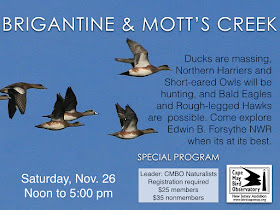Ruddy Turnstone
© Brett M. Ewald
As the fall migration winds down
and your attention switches to the opportunities that winter birding presents,
CMBO is here to help. Our Winter edition of the Kestrel Express is out –
highlighting all of our weekly walks, special field trips, and Cape May School
of Birding workshops -
Programs
Programs
Please note a new monthly walk at
Hidden Valley – this is a free walk sponsored by the NJDEP Division of Fish
& Wildlife. The first walk is schedule for Sunday, December 11th at 4
p.m. - meet at the small clamshell parking lot on the south side of New England
Rd., 0.3 miles west of the intersection with Bayshore Road. Hope you’ll join
us!!
A full spectrum of in-depth and
informative Workshops and Birding Breaks are already planned for 2017– Cape May School of Birding.
Sign up today to reserve your spot, or gift one to a friend! Check back often
for the latest additions to this extensive line-up, as several more are in the
works.
Of course, for those focused on
the quickly approaching holiday season, stop in at the Northwood Center in Cape
May Point for all sorts of gifts, perfect for the nature lover in your life –
binoculars, scopes, shirts, jewelry, caps, field guides and other natural
history books, notecards, feeders, coffee, and more!!!!
